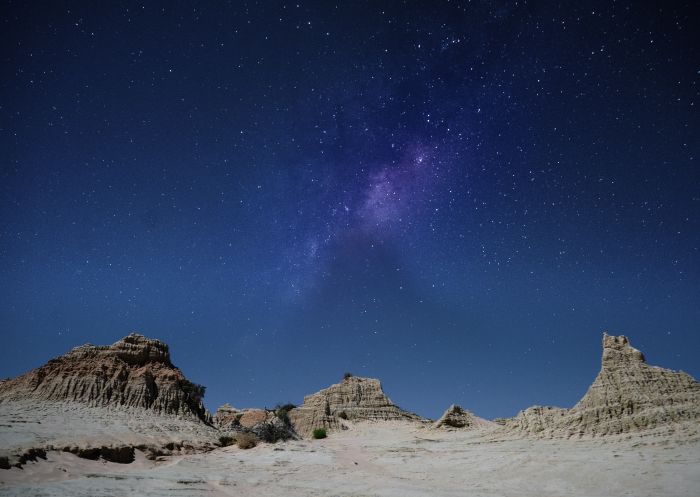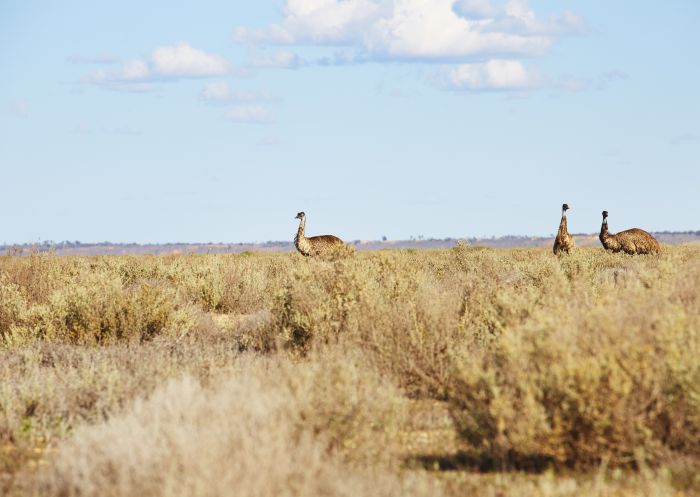

Mungo National Park
Mungo National Park - Credit: Tyson Mayr



Uncover a starkly beautiful landscape of ancient dry lake basins and sand formations in Mungo National Park. Home to Mungo Woman and Mungo Man, this area of NSW is rich with Aboriginal history and is of great significance to the local indigenous people.
In the Willandra Lakes World Heritage Area, the archaeological discoveries of the bones of Mungo Woman and ochred skeleton of Mungo Man – the world's oldest human cremations – reveal early evidence of developing spiritual belief.
These fascinating 42,000-year-old ritual burials, along with past human footprints, tell an incredible story about the long history of Australian Aboriginal people, and led to the establishment of Mungo National Park.

The night sky over the Walls of China in Mungo National Park - Credit: Tyson Mayr
Explore Mungo National Park your own pace or with an organised tour such as Tri State Safaris or Outback Geo Adventures. Along the eastern side of the lakes, there are towering dunes formed from quartz and clay. The most famous of these formations is the colossal Walls of China. You can take a tour of this magical landmark with an Aboriginal ranger, and learn about the cultural history of Lake Mungo.
The 70km Mungo Self-Guided Drive Tour is a brilliant introduction to this unbelievable desert landscape. Starting at the Mungo Visitor Centre, the loop track takes in all the main attractions of the park including the Walls of China boardwalk, Red Top lookout and Rosewood picnic area. A 4WD vehicle is recommended.
The fish and waterbirds may be long gone, but keep an eye out for mobs of prancing emus, screeching cockatoos and giant red kangaroos. Drop into the Mungo Visitor Centre for tourist information, and to learn about the park’s megafauna and the formation of its unique landscape.

Emus in Mungo National Park
You can cycle or drive the 10km historic Zanci Pastoral Loop to see wildlife, birdlife and the ruins of Zanci Homestead. For many years this region was a grazing property. Built in 1869, Mungo Woolshed is a well-preserved and vivid reminder of those times.
If you want to stay overnight, there are campgrounds as well as budget accommodation in the historic Mungo Shearers’ Quarters or modern cabins at Mungo Lodge.

Mungo Lodge, Mungo National Park
Mungo National Park is a 10hr 30min drive from Sydney, 6hr 30min drive from Melbourne and just under seven hours’ drive from Adelaide. Mildura is a 1hr 30min drive from the national park via unsealed roads. There are direct flights from Mildura to Melbourne. Check for road closures before you travel at the NSW National Parks website and download the National Parks app for maps and information.
Mungo National Park is always open but may have to close at times due to poor weather or fire danger. Check the NPWS website for the latest travel alerts and closures.
All routes into Mungo National park are good quality, two-wheel-drive unsealed roads. You do not need a 4WD to drive them in good weather. However, there are often road closures during or after wet weather.
Since road conditions can change quickly in the outback, before you travel you should check what roads are open or closed within Mungo National Park, as well as the roads leading to the national park from nearby towns. This advice can be obtained from Balranald, Wentworth and Mildura visitor information centres.
The best time to visit Mungo National Park is in either autumn or spring, when it’s not too hot.
Itineraries in Mungo National Park can range from half-day tours to camping trips spread over seven days. A minimum of two nights is recommended to truly experience everything this beautiful landscape has to offer.
Pets (other than certified assistance animals) are not permitted at Mungo National Park.
The entry fee for Mungo National Park is $8 per vehicle per day. Fees are payable through self-registration envelopes outside Mungo Visitor Centre. Different fees apply for commercial tour operators and vehicles with eight seats or more.
There’s limited Telstra mobile phone reception in the park. In emergencies a ranger can be contacted on UHF channel 3. Plan ahead by downloading some offline maps.
There are several toilet facilities within Mungo National Park. Locations include:
Stay connected to Visit NSW for all the latest news, stories, upcoming events and travel inspiration.
All the insider news, tips and inspiration you need to plan your next trip, delivered straight to your inbox.
Sign UpVisitNSW.com is the official tourism site for Destination NSW.
© Copyright 2025 Destination NSW. All rights reserved